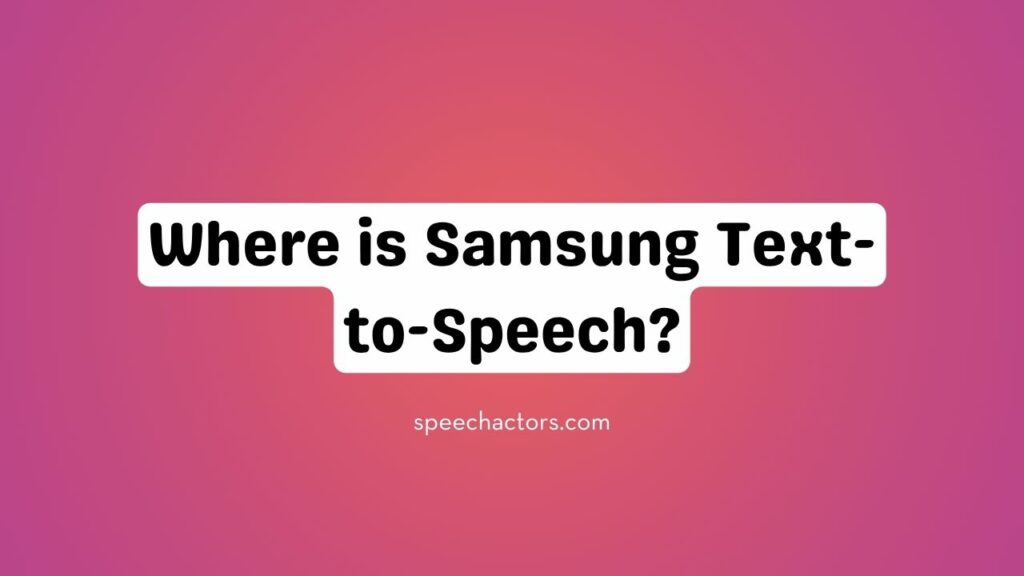Samsung Text-to-Speech (TTS) is a powerful feature that enhances the accessibility and usability of Samsung devices, providing users with a seamless audio experience. Whether you’re navigating through apps, reading messages, or consuming content, this feature can make everyday tasks easier.
With its clear and natural-sounding voice options, Samsung TTS is designed to cater to various user needs, promoting inclusivity for those with visual impairments or those who prefer audio over text.
In this blog, we’ll explore the functionality, benefits, and settings of Samsung Text-to-Speech, helping you unlock its full potential.
What is Samsung Text-to-Speech (TTS)?

Samsung Text-to-Speech (TTS) technology converts written text into natural-sounding speech. It’s designed to help users by reading text aloud in various languages with clear, expressive voices.
Samsung TTS works smoothly across multiple devices, including smartphones and tablets, making it a convenient tool for users. The technology has features like adjustable voice speed and different language options, allowing a personalized experience.
One of the key strengths of Samsung TTS is its ability to produce lifelike, human-like voices, making it stand out from other TTS technologies. Whether you’re reading articles, messages, or using apps, Samsung TTS offers a seamless and accessible way to interact with text.
Evolution of Samsung TTS: Where Did It Start?
Samsung’s Text-to-Speech (TTS) system has evolved significantly since its introduction. It all began in the early 2010s with Samsung’s push to enhance accessibility for its users, making it easier for visually impaired individuals to interact with their devices.
Over the years, Samsung TTS has evolved with major improvements in natural voice quality and multi-language support. Key milestones include the introduction of Samsung’s S Voice in 2012 and the integration of AI-driven voices in newer models.
When compared to other industry leaders like Google and Apple, Samsung has focused on creating a localized experience, offering voices tailored to different languages and dialects, enhancing accessibility for global users.
Why Has Samsung’s TTS Been Hard to Find?
Samsung’s Text-to-Speech (TTS) technology has become harder to find due to recent changes in its product lineup and software updates. Over time, Samsung has shifted its focus to integrating TTS into specific devices rather than offering it universally.
Now, the TTS feature is mainly built into their smartphones, smart TVs, and Bixby, Samsung’s virtual assistant. With each new software update, Samsung refines how TTS is used across its products, making it more specialized and tailored for particular functions.
While it’s still available, its accessibility has become more device-dependent, making it less visible to users on older or non-supported models.
Current Availability of Samsung TTS
Samsung Text-to-Speech (TTS) is available on a wide range of Samsung devices, including smartphones, tablets, and wearables like the Galaxy Watch. It supports various languages, including English, Spanish, French, German, Italian, and many others, offering a diverse set of voices for each language.
To access Samsung TTS on compatible devices, simply go to your device’s settings, select “Accessibility,” and then choose “Text-to-Speech.”
From there, you can enable the Samsung TTS engine and select your preferred language and voice. It’s a great tool for reading out text, making it easier to access content hands-free.
Samsung TTS vs. Competitors: A Comparison
Samsung TTS is a native text-to-speech engine found in Samsung devices, but how does it compare to Google Text-to-Speech and Apple TTS? Here’s a breakdown based on engine quality, performance, language support, and real-world applications:
Samsung TTS is ideal for basic mobile usage but lacks the advanced capabilities and voice fidelity of Google TTS and Apple TTS. For apps needing expressive, lifelike narration or multilingual support, Google TTS offers the best performance with robust developer tools and extensive voice models. Apple TTS is best for users embedded in the Apple ecosystem.
How to Use Samsung TTS Effectively
Samsung TTS (Text-to-Speech) is a helpful feature that turns text into spoken words, making it easier for users to interact with their device. To enable it, go to Settings, tap on Accessibility, then select Text-to-Speech. From there, choose Samsung TTS as your preferred engine. You can adjust the speech rate and pitch to suit your preference.
To use it, highlight the text you want to hear and select the Speak option. The device will read it out loud clearly. For a better experience, ensure you have a stable internet connection and update the TTS engine regularly for improved accuracy and performance.
Future of Samsung TTS Technology
Samsung is advancing its Text-to-Speech (TTS) technology to deliver more natural, expressive, and personalized voice interactions.
Samsung’s integration of AI into its Galaxy devices enhances TTS capabilities by offering features such as real-time translation, voice customization, and personalized voice synthesis. These advancements aim to provide users with more intuitive and engaging interactions across various applications and devices.
Through ongoing research and development, Samsung is committed to refining its TTS technology to meet the evolving demands of users, ensuring more dynamic and human-like voice experiences.
Conclusion
Samsung’s Text-to-Speech (TTS) technology has evolved over the years, becoming a powerful tool for accessibility and interaction on its devices.
With its advancements, users now have access to more natural-sounding voices and improved integration. We encourage you to explore these TTS features on your Samsung device and unlock enhanced experiences.
To further improve accessibility and engagement, discover the wide range of TTS options available at Speechactors. Start enhancing your audio experiences today and embrace the future of seamless communication!
